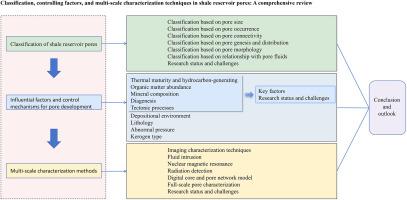Classification, controlling factors, and multi-scale characterization techniques in shale reservoir pores: A comprehensive review
IF 5.5
0 ENERGY & FUELS
引用次数: 0
Abstract
The size, distribution, and connectivity of pores play a critical role in determining the characteristics and formation of shale reservoirs. Therefore, pore analysis is critical for the reservoir evaluation. Considering the lack of a comprehensive overview, this paper reviews advancements in pore classification schemes, the factors and mechanisms controlling pore occur, and multi-scale characterization methods. We present an integrated analysis of pore classifications based on various criteria, including pore size, occurrence, connectivity, genesis, distribution, morphology, and their relationship with pore fluids. Thermal maturity, organic matter abundance, mineral composition, diagenesis, and tectonic processes are identified as key geological factors that govern pore formation and development. This study also highlights the evolution of experimental techniques, which have greatly enhanced the ability to characterize shale pores accurately. However, a unified classification system for shale reservoir pores is still lacking. A precise quantitative analysis of the influence of each geological factors on shale pore development remains absent. Each pore characterization method, while offering distinct advantages, also has its own limitations in terms of range and accuracy. When integrating multiple methods for comprehensive shale reservoir characterization, issues like poor data compatibility and difficulties in integration still exist. Future research should prioritize the standardization of shale pore classification, the quantitative assessment of geological factors influencing pore development, and the establishment of a comprehensive pore characterization framework and set of standards. This paper seeks to advance the understanding of shale reservoir pores, providing valuable insights and references for subsequent studies.

页岩储层孔隙分类、控制因素及多尺度表征技术综述
孔隙的大小、分布和连通性是决定页岩储层特征和形成的关键因素。因此,孔隙分析是储层评价的关键。鉴于缺乏全面的概述,本文综述了孔隙分类方案、控制孔隙发生的因素和机制以及多尺度表征方法的研究进展。本文基于孔隙大小、产状、连通性、成因、分布、形态及其与孔隙流体的关系等不同标准,对孔隙分类进行了综合分析。热成熟度、有机质丰度、矿物组成、成岩作用和构造作用是控制孔隙形成和发育的关键地质因素。该研究还强调了实验技术的发展,这些技术大大提高了准确表征页岩孔隙的能力。然而,目前还缺乏统一的页岩储层孔隙分类体系。目前还没有对各个地质因素对页岩孔隙发育的影响进行精确的定量分析。每种孔隙表征方法虽然具有各自的优势,但在范围和准确性方面也有其局限性。在整合多种方法进行页岩储层综合表征时,仍然存在数据兼容性差、整合困难等问题。今后的研究重点应是规范页岩孔隙分类,定量评价影响孔隙发育的地质因素,建立全面的孔隙表征框架和标准体系。本文旨在促进对页岩储层孔隙的认识,为后续研究提供有价值的见解和参考。
本文章由计算机程序翻译,如有差异,请以英文原文为准。
求助全文
约1分钟内获得全文
求助全文

 求助内容:
求助内容: 应助结果提醒方式:
应助结果提醒方式:


